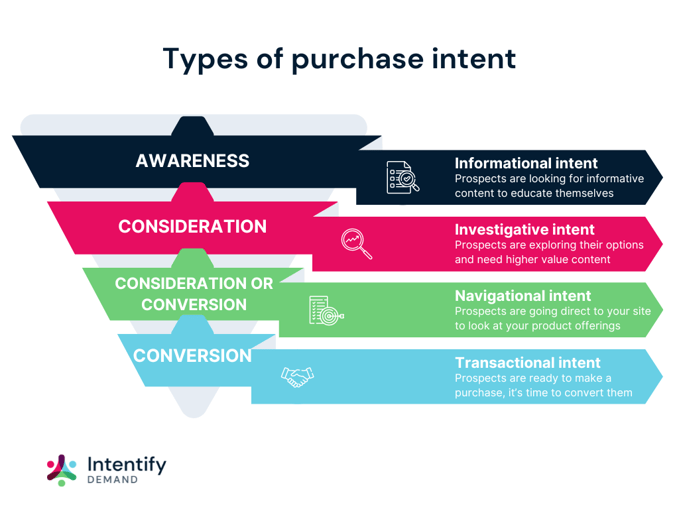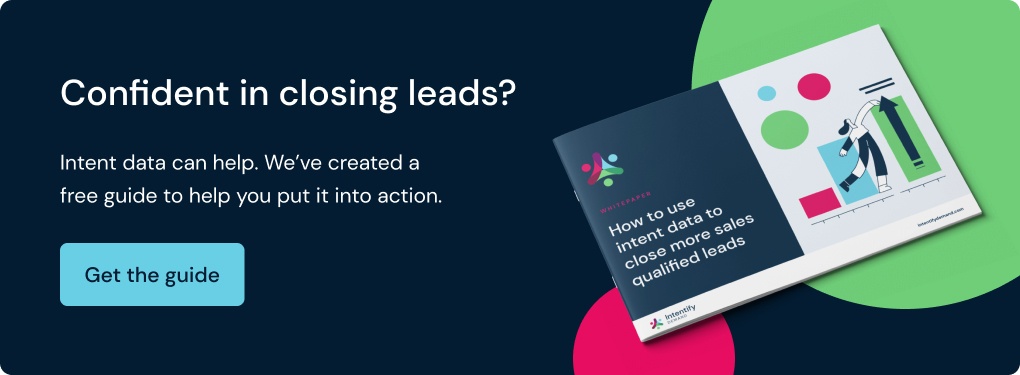Read time: 6 minutes
With many marketers struggling with leads that don't convert and sales under pressure to reach ever-climbing targets, understanding the buying behaviours of your ideal customer profile (ICP) is crucial.
In order to stay ahead of the competition and create meaningful connections with prospects, marketers are turning to purchasing intent to help inform decisions and provide tailored marketing strategies. The emergence of cutting-edge artificial intelligence (AI) and machine learning (ML) tools empowers tech-savvy marketers to leverage the power of purchase intent to deliver relevant and timely strategies that do engage and drive towards conversion.
It happens. But we understand how frustrating and time-consuming it can be. That's why determining purchase intent is so important.
What is purchase intent?
Purchase intent indicates the likelihood of a person buying your product or service. It can help you identify best-fit opportunities and increase your likelihood of converting leads.
The purchase process, particularly in B2B, can be long and complex, so understanding purchase intent can help marketers better interpret online consumer behaviour. Knowing which stage in the buying journey an individual is at can go a long way in better understanding what would make them convert into a paying customer
What's the difference between purchase intent and buying intent?
Buying intent is simply another term for purchase intent. They both refer to the intent around making a purchase and are often used interchangeably.
Why is purchase intent important?
Marketers can no longer afford to simply guess when it comes to converting prospects. Leads are too valuable to gamble with, so purchase intent can be a great way to shed some visibility on which marketing strategy will be the most effective.
It makes it easier for marketers to garner the right engagement, create the most relevant content and therefore boost conversion rates.
4 types of purchase intent
Understanding the different types of purchase intent means you can effectively engage potential customers by providing them with the most relevant content at the right time.
Informational intent (awareness stage)
This stage is mostly concerned with education. Individuals will be reading content with the aim of educating themselves or solving a particular pain point. Informational intent is quite an early stage in the buying process, so marketers should focus on brand awareness and providing informative resources such as blogs, articles, whitepapers and videos that will help individuals move down the marketing funnel.
Investigative intent (consideration stage)
With so many products now available on the market, potential customers will often spend the longest in this stage. According to research from DemandGen, 62% of B2B buyers will consume 3-7 pieces of content when making a purchase decision before they even engage with a salesperson.
As prospects in this stage are slightly further down the funnel, marketers should consider content formats that show clear value propositions and clearly explain your business differentiators. The same research from DemandGen found that 48% of B2B buyers find webinars more valuable for this stage of the funnel (compared to just 31% of blog posts and 34% of whitepapers).
Navigational intent (consideration or conversion stage)
Navigational intent is usually associated with a higher level of intent as an individual is seeking out a specific web address. This suggests the prospect has a clear idea of what they want. Once an individual has landed on your website, the challenge is keeping them engaged and providing enough relevance that they don't go elsewhere. To do this, marketers should consider user experience, personalised promotions and content recommendations to build an overall strong customer experience.
Transactional intent (conversion stage)
Often characterised by specific, high-intent keywords such as buy or purchase, transactional intent is most likely to equate with an actual purchase. Individuals at this stage show a high propensity to buy and are ready to convert. This means it's important for marketers to make that conversion journey as seamless as possible, whether that's optimising your pricing page or providing easy access to product demos.

How do we find best-fit leads using purchase intent?
At Intentify Demand, we determine purchase intent to a 95% degree of accuracy. Here's how we do it.
The first step is to listen to your campaign needs and familiarise ourselves with your ICPs and buyer personas. This information will inform how Pelago, our unique artificial intelligence, will narrow down our first-party data and pinpoint contacts with high purchase intent.
Here's how Pelago does this:
1. It analyses technographic and firmographic data
Much like demographics, technographic and firmographic data reveal valuable ICP information. We can then match this to your criteria.
What is firmographic data?
Firmographic data consists of company information. This includes industry (e.g. SaaS, B2C ecommerce), location, company size, and company performance metrics (e.g. annual revenue, market share).
What is technographic data?
Technographic data provides insights into the technology stack being used at specific companies. It can also reveal the software they don't use or the software that's outdated and should be replaced. This is useful for adjusting your outreach approach.
Recommended reading: 10 intent data terms that you need to know
2. It deploys TextRank in NLP
So this is the technical bit...
- Natural language processing (NLP) is an area of computer science that allows technology to identify context in written text and spoken words
- TextRank is a graph-based ranking model that harnesses NLP
Combining the two means Pelago is able to find relevant keywords and similar phases in our datasets.
For example, if a client wants to target not-for-profit companies, Pelago will extract contacts with ‘not-for-profit' in their metadata.
3. It maps online behaviour
While the previous two steps focus on gathering ICP data, it's impossible to determine purchase intent with words alone. To understand a contact's probability of buying, we map their online behaviour patterns and focus on:
- Scroll velocity - mapping how far a person scrolls on a page and at what speed. If a contact reads 75% of a blog post about how to boost employee productivity, there's a strong chance they suffer from an unproductive workforce. For SaaS companies with a project management-focused product, this could be a telling indicator of purchase intent.
- Page time suggests the interest a contact has in a subject. The longer they spend on a page, the more interest they have.
- Asset downloads. The whitepapers and ebooks a contact downloads can indicate their current mindset. For instance, downloading a guide titled ‘How to choose the best intent data company' suggests a lead is in the consideration phase of the buying journey.
Scoring leads based on purchase intent
94% of marketers agree that using purchase intent data gives them a competitive advantage, and that's a statistic you can't argue with. But knowing how to interpret that data and use it to inform your marketing strategies can be tricky.
At Intentify Demand, we use the context you give us to find tailored, best-fit lead opportunities.
Each lead is assigned a numerical purchase intent value. The higher the value, the more likely they are to engage with your business. And the more likely they'll want to purchase your product or service, making it easy to target the right leads.
This article was updated 11th January, 2024




